Make a popular Korean favorite at home: Seafood Soondubu Jjigae! Also known as Korean Tofu Soup, it’s a simple and delicious Korean soup that stars soft, silken tofu. A spicy, savory broth makes it especially delicious! In this seafood version, there are big chunks of shrimp, squid, and clams. A beloved Korean classic and pure comfort food!
Table of contents
What is Soondubu Jjigae?
Soondubu Jjigae, also known as Korean Soft Tofu Soup, is a spicy and addictively delicious Korean stew. The main ingredient is extra silken tofu, called soondubu in Korean. A tofu that’s so unbelievably soft, it melts in your mouth. Combined with a rich and savory anchovy broth that shimmers with spicy oil, it’s a comforting favorite on cold days. A classic Korean recipe!
At Korean restaurants, there are different versions of Korean Soft Tofu Soup. My recipe is a seafood version, also called Haemul Soondubu Jjigae. To make it easier, use a package of mixed frozen seafood. Simply defrost in cold water and enjoy all the briny flavor of the sea with big chunks of shrimp, clam, squid, etc. YUM!
Korean Tofu Soup is also easy to make at home. Simple enough for weeknight dinner. And so good with rice!
Enjoy! Nothing cozier than a bubbling hot bowl of Soondubu Jjigae!

Ingredients:
Don’t let the long ingredient list intimidate you! Many of the ingredients are Korean pantry staples. They are the base of Korean cooking and are used for making many other dishes.
- Soondubu or Extra Silken Tofu. The star ingredient. Goes by many names: Soondooboo, Soon Tofu, Soft Silken Tofu or Extra Silken Tofu. Look for it at Asian grocery stores, in the refrigerator section wrapped in plastic tubes or boxes.
- NOTE: Soondooboo is the Korean word for extra silken tofu — tofu that is so soft that it barely holds onto its shape. When added to the broth, it breaks apart easily into fluffy, cloud-like chunks. The ultimate in silky, velvety smooth texture! Soondooboo is tofu that is not pressed. In soup, it will melt away into soft, fluffy goodness.
- Frozen Seafood. For ease and convenience, I use frozen seafood that includes an assortment of clams, mussels, squid, and shrimp. Any mix of shrimp, clams, and squid works great. If you’d like to add fresh seafood, that’s great too. I like clams, squid, and shrimp.
- Anchovy broth. The flavor base of the stew. Adds rich seafood flavor. My Korean grandma makes homemade anchovy stock the traditional way and keeps it on hand. To make it easier, I use Hondashi or Japananes instant dashi stock (affiliate), powdered anchovy bouillon (affiliate), or anchovy tablets (affiliate).
- Pork. A little bit adds richness and depth.
- Onion + Garlic. The aromatic base of this flavorful Korean stew.
- Gochujang. Korean fermented chili paste.
- Gochukaru. Korean dried chili flakes, also known as red pepper flakes.
- Sauwoojut. Korean fermented shrimp paste. Adds lots of seafood flavor.
- Fish sauce. Just a splash at the end!
- Soy Sauce. Deep umami richness and flavor.
- Sugar. A pinch rounds out all the flavors.
- Sesame Oil. Fragrant and nutty. Add a drizzle just before serving!
- Egg. For serving. Adds velvety richness and silky smoothness.

How to make Korean Soft Tofu Soup
- Defrost frozen seafood. Cover with cold water and set aside to defrost for 15 minutes. (Check package directions).
- Cook pork + onion. Cook ground pork, onion, Gochukaru, and Gochujang in oil until the fat renders out of the pork and the onion becomes fragrant.
- Make broth. Add anchovy broth, garlic, sugar, and defrosted seafood. Bring to a simmer. Add soft silken tofu and Saewoojut, Korean salted shrimp.
- Add egg. Off the heat, crack a raw egg directly into the cooking pot. Mix around; the residual heat will gently cook the egg. You can leave out the egg but the texture and flavor will not be exactly the same; the broth will be thinner and less rich.
- Garnish and serve. Add green onions, a drizzle of sesame oil, and enjoy with rice!
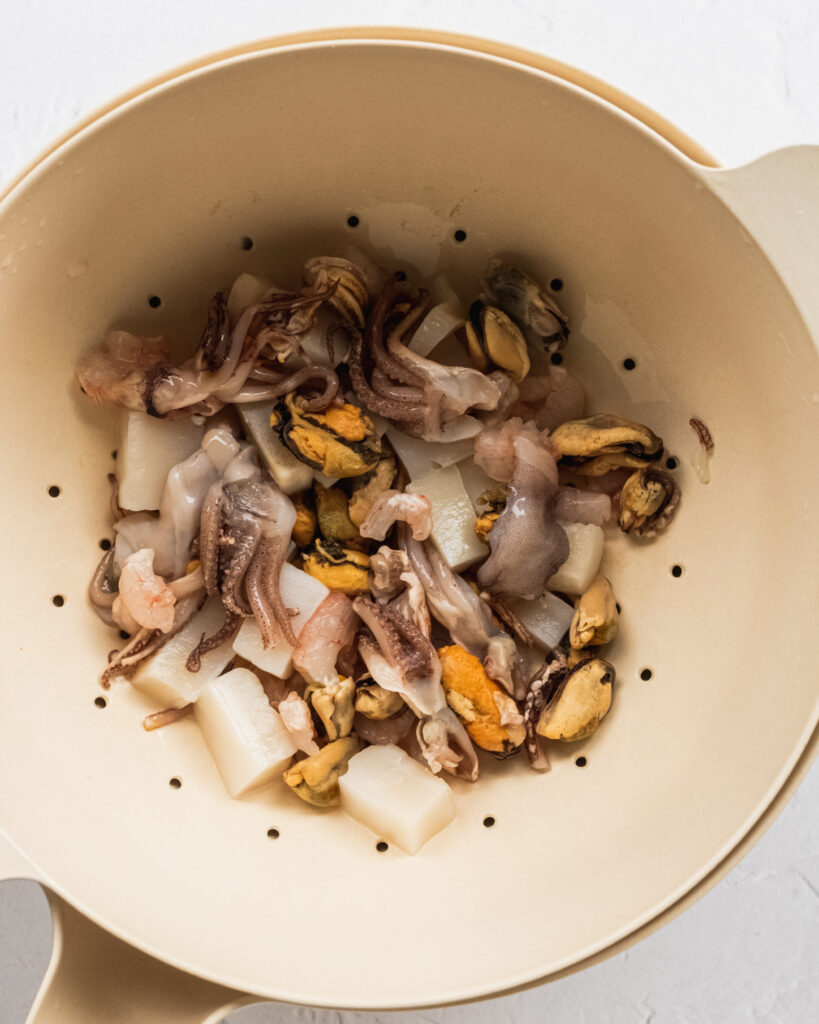

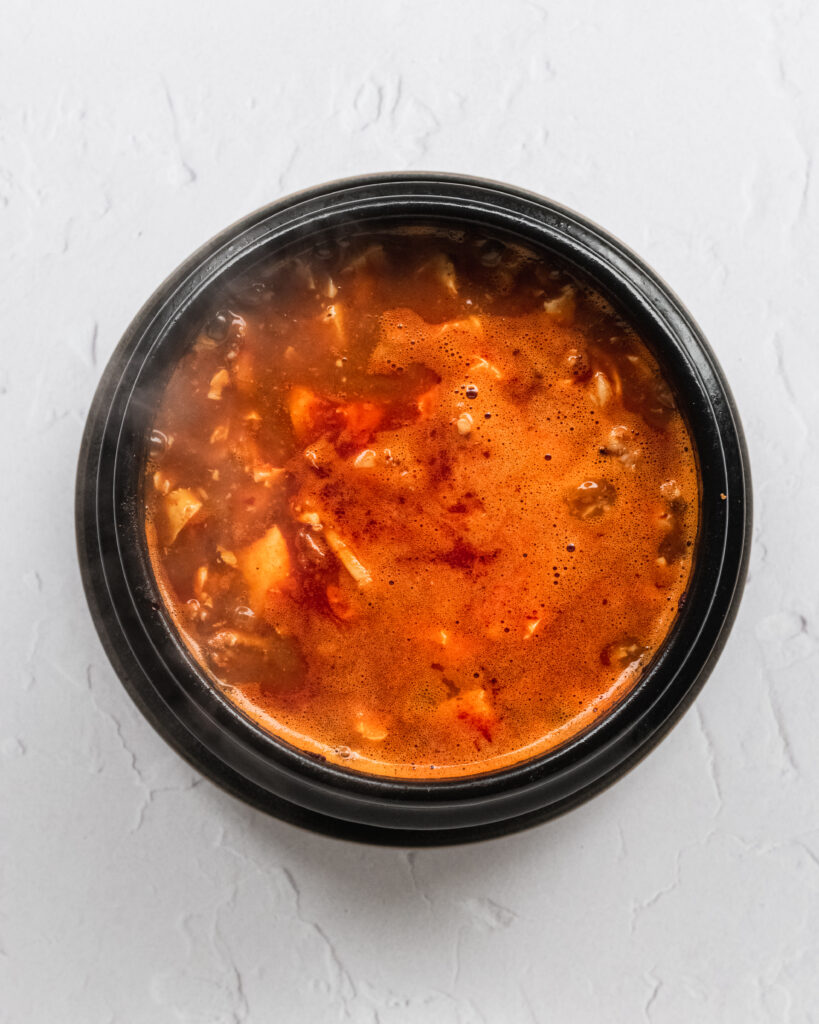
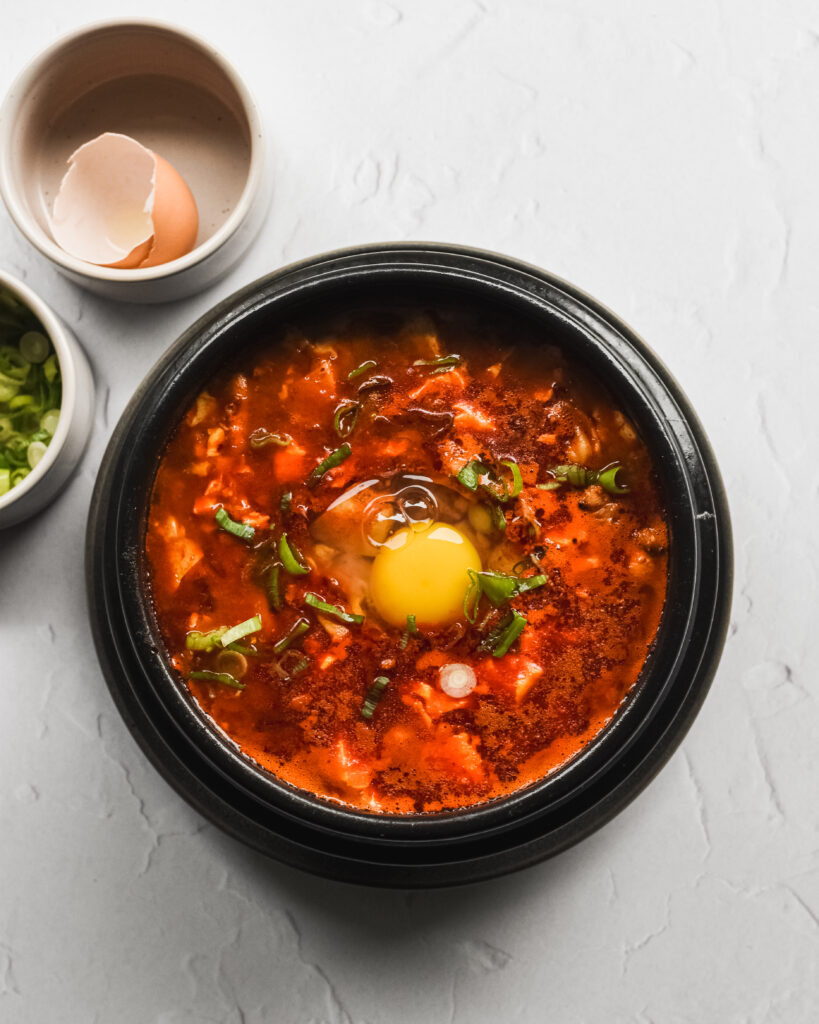

Watch how to make it:
PRO Tips
- Serve with a raw egg. To make it complete — crack in a raw egg just before eating. The residual heat will gently cook the egg, creating a velvety smooth texture and richness.
- Adjust the spice level. If you’d like more heat, add 1-2 Tbsp more Gochukaru. Also, top with a fresh minced chili like fresno or Jalapeno pepper or whole mustard seeds right before serving. If you’d like it less spicy, reduce the amount of Gochukaru and Gochujang.
- Taste and adjust seasonings. Since fermented food items (in this case – gochujang, soy sauce, fish sauce, sauwoojut) change over time and the soft silken tofu can dilute the flavor of the broth, taste and adjust seasonings right before serving. If bland, add a splash of fish sauce. If too salty or too tangy, add a pinch of sugar.
- Serve in a Korean clay pot (Ttukbaegi). If you have one, a medium-sized (1000ml) earthenware bowl is perfect for serving Seafood Soondubu Jjigae. The clay pot keeps the jjigae hot and bubbling.
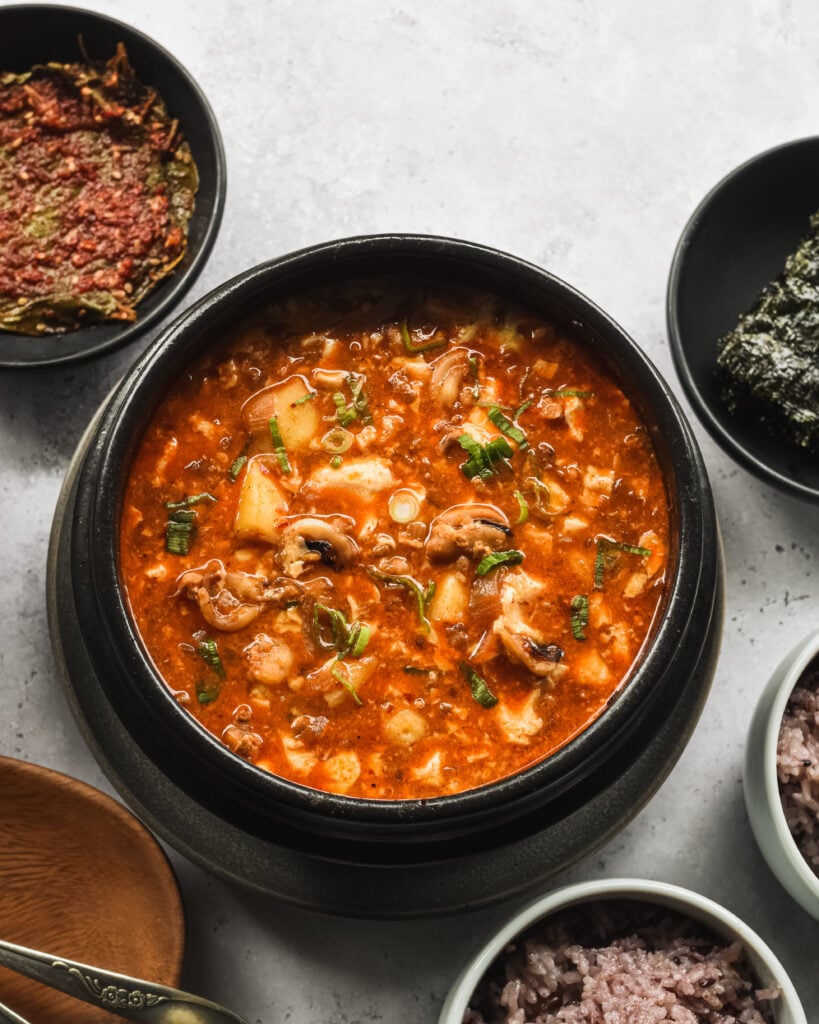
FAQ:
Soondubu comes in plastic-covered, tube-shaped packages or plastic sealed boxes. Look in the refrigerated section at the Asian market.
Korean Soft Tofu goes by many names: Soondooboo, Soon Tofu, Soft Silken Tofu or Extra Silken Tofu.
If your soondooboo comes in a plastic tube, look for a dotted line. That dotted line tells you where to cut, but don’t cut all the way through! Cut halfway, then open the package like a hinge. Once opened, spoon or squeeze the extra silken tofu directly into the cooking pot.
Soft Silken Tofu is an essential ingredient for Soondubu Jjigae. There really is no substitute. If you use a firmer tofu, the texture won’t be quite the same.
The main difference is the kind of tofu that’s used. Soondubu Jjigae is made with Korean soft, silken tofu. It can contain kimchi but doesn’t always. In Kimchi Jjigae, the star ingredient is lots of aged, sour kimchi for a completely different flavor profile.
Fresh seafood tastes very good in Korean Soft Tofu Soup. Especially the special flavor of fresh clams. If you live close to a fishmonger, that’s what I recommend.
However, the ease and convenience of frozen seafood make this an easy weeknight meal. Stock up when they go on sale and stash in the freezer. Seafood freezes very well. Once defrosted, you can’t even tell it’s been previously frozen.
FYI Asian markets usually sell packages of mixed frozen seafood. The mixed seafood packages provide little bit of everything: mussels, clams, squid, and shrimp.
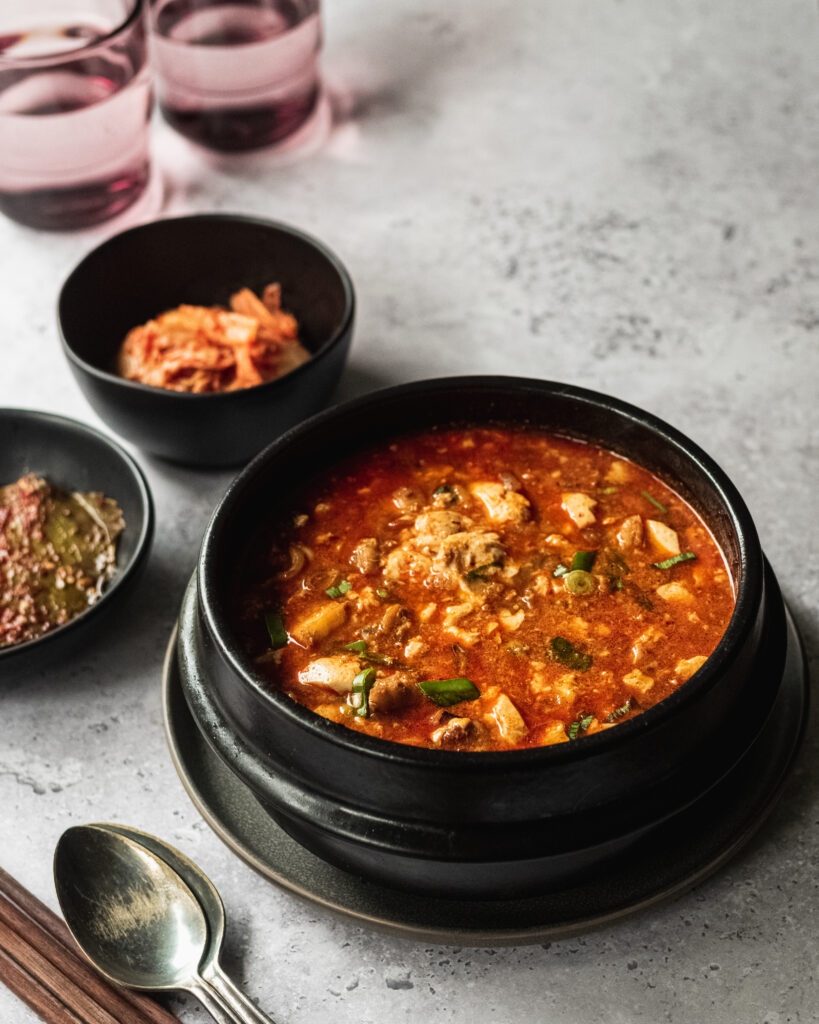
More Korean soups:
- Kimchi Jjigae with Pork Belly
- Korean Rice Cake Soup with Dumplings (Tteok Mandu Guk)
- Doenjang Jjigae (Soybean Paste Stew)
- Korean Oxtail Soup (Kkori Gomtang)
- Budae Jjigae (Army Base Stew)
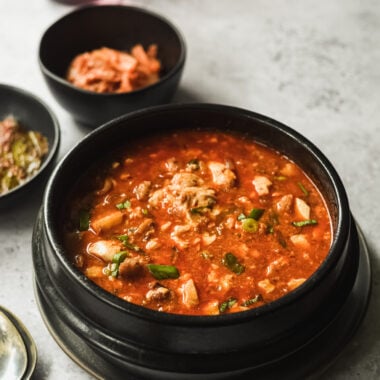
Spicy Seafood Soondubu Jjigae (Korean Tofu Soup)
Equipment
- Ttukbaegi (Korean clay pot) OR medium saucepan 1000ml
Ingredients
- 1 360g/12 oz frozen seafood pack
- 1 Tbsp neutral cooking oil (avocado oil, canola oil, grapeseed oil, etc.)
- 1/4 cup ground pork
- 1/2 large onion, chopped
- 2 Tbsp Gochukaru (Korean dried chili flakes) (1 Tbsp if you'd like it less spicy)
- 1 Tbsp Gochujang (Korean fermented chili paste)
- 1 Tbsp soy sauce
- 3/4 cup anchovy broth or water
- 2 cloves garlic
- 1/2 tsp saewoojut (Korean fermented, salted shrimp)
- 1/2 tsp sugar
- 1 package Soondubu or Soft Silken Tofu
- splash fish sauce
- 1 large egg (preferably organic)
Instructions
- Defrost. Defrost frozen seafood according to package directions. Cover with cold water for 10 minutes or run under cold water for 3-5 minutes. Drain and set aside.
- Cook pork. Heat a medium cooking pot (or Korean clay pot, a Ttukbaegi) over medium heat and add 1 tsp cooking oil. When the oil is warm (but not smoking), add the ground pork. Cook until the pork is no longer pink, about 3-4 minutes.
- Add onion, Gochukaru, and Gochujang. Cook until the onion has softened, about 3-4 minutes. Lower heat if necessary, making sure the Gochukaru doesn't burn. Add soy sauce and mix for 30 seconds. The mixture will be thick, pasty, and oily looking.
- Make broth. Add water, garlic, and sugar, mixing well with a spoon. Bring to a simmer. When the pot is bubbling, add defrosted, drained seafood and saewoojut. At first, it will look like there's too much seafood. But it will shrink down and release liquid. Cook until the seafood is 90% cooked through, about 5 minutes.
- Add soft tofu. Add soft silken tofu (soondooboo) and mix gently, breaking up the curds. Taste and add a splash of fish sauce, if needed. Cook until heated through. It should be bubbling.
- Add egg. Remove from heat and crack a raw egg directly into the pot. (Optional step but highly recommended). Mix gently. Eat immediately with rice, kimchi, and other banchan (side dishes) of choice!
Video
Notes
- Make it spicier. If you’d like more heat, add 1-2 Tbsp more Gochukaru. Also, top with a fresh minced chili like fresno or Jalapeno pepper or whole mustard seeds right before serving.
- Taste + Adjust seasonings. Since fermented food items (in this case – gochujang, soy sauce, fish sauce, sauwoojut) change over time and the soft silken tofu can dilute the flavor of the broth, taste and adjust seasonings right before serving. If bland, add a splash of fish sauce. If too salty or too tangy, add a pinch of sugar.
- Serve in a Korean clay pot (Ttukbaegi). If you have one, a medium-sized (1000ml) earthenware bowl is perfect for serving this homey stew. The clay pot keeps the jjigae hot and bubbling.






I used the base to make kimchi soft tofu stew and it was perfect! Thanks Lis for the best recipes